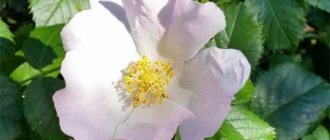Peony is a beautiful flower with which humanity has been familiar for more than two thousand years. The name of the flower is associated with the name of the ancient Greek god-healer Paean (Peon), who healed Hades and Ares themselves. And it was precisely for its beauty, combined with its healing properties, that the plant entered the culture under the “divine name”.
Modern peonies occupy one of the leading positions among garden plants and can only compete with roses for primacy.
Bright, unpretentious flowers decorate patios, flower beds, garden complexes and greenhouses. They are loved by landscape designers, florists and amateur gardeners. The magic and aroma of the flower attracts the eye and, of course, evokes the most romantic emotions, which is why in Asian countries peonies are nicknamed “flowers of love.”
Description of the plant
Peonies (Paeonia) are perennial herbaceous, shrub and subshrub plants of the Peony family (Paeoniaceae). There are 36 species growing in nature, from which more than five thousand varieties have been bred.
The distribution area includes the temperate and subtropical zones of North America and Eurasia.
Peonies are equipped with a powerful root system in the form of large cones. Several massive stems become woody with age, turning into trunks and do not branch much.
The shape of the leaves is pinnate, divided into lobes. The color of the leaves is dark green, gradually changing depending on the time of year to dark lilac.
Peonies bloom in large flowers, with numerous petals and are represented in the entire color palette.
After flowering, a fruit is formed in the form of a composite, star-shaped multi-leaflet, which contains seeds.
Peonies have been used in cooking and medicine for several thousand years. Their petals are used to make salads, drinks and candied fruits. Tinctures from peony petals have sedative properties and are used as an anti-allergenic and sedative.
Types, varieties, names with photos
Both wild and varietal types of peonies are divided according to a number of criteria. Most botanists rely on the following classification.
According to the form of growth.
Tree Peonies
Tree peonies are represented by natural, hybrid and varietal species. These are shrubs no more than two meters high, which have thick, erect, non-branching shoots.
Tree peonies are divided into 3 varieties:
- Japanese peonies. These are frost-resistant shrubs, with medium-sized flowers and semi-double petal texture;
- European peonies, which are characterized by large leaves and velvety flowers of various colors;
- A hybrid based on two species - “Yellow” and “Delaway”. This is a variety of tree peony with extraordinary bright yellow flowers.
Herbaceous Peonies
These peonies grow in the form of perennial herbs and are famous for their unpretentiousness and hardiness.
They also have an internal classification and are divided into subspecies:
Peony Milky-flowered or White-flowered / Paeonia Lactiflora
This type of peonies is the most popular garden plant. The tall stem is topped with a large flower. It is this species that is the progenitor of more than 1000 varietal peonies, so the color of the flowers can be found from white to black.
Peony Evading or Maryin Root / Paeonia Anomala
It has a thick stem, crowned with a large fiery pink flower.
Mlokosewitschii Peony / Paeonia Mlokosewitschii
You can meet him high in the Caucasus Mountains (Lagodekhi Gorge). Large, soft yellow flowers, pink stems and leaves with a bluish tint. This type of peony also has popular names such as “golden peony” and “molly witch”.
Peony Officinalis or Common Peony / Paeonia Officinalis
The most famous type of peony, which has been grown for centuries to make medicinal products. But thanks to its rich, pink color, it has acquired decorative significance in the modern world.
Narrow-leaved Peony or Voronets Peony / Paeonia Tenuifolia
The flowers are solitary and small, about 6 centimeters in diameter. The color of the petals is dark red and dark pink.
Peonies are also classified according to the shape of the buds and the number of petals.
Terry peonies
This species is characterized by wide, rounded petals, which are arranged in dense rows. The stamens are so modified that they are visually difficult to separate from the petals.
The flower shape of double peonies is also divided into:
- rose-shaped
- semi-pink
- spherical
- hemispherical
- crowned
Semi-double peonies
Such a flower consists of 5-7 true petals and several rows of petal and ordinary stamens. This combination gives the flower a very graceful shape and elegance.
Non-double peonies
The bud consists of no more than 10, or even less, petals, which are framed in an even circle by the stamens of the correct shape.
Japanese peonies
The flower includes a mix of full petals and modified (petal) stamens, tightly intertwined. A distinctive feature of Japanese peonies is that the stamens and petals differ in color, and thereby create a variegated, spectacular color of the flower.
Anemone peonies
There are no more than 7 petals in the inflorescence. The main space is occupied by dense rows of long and bright stamens.
According to the timing of flowering, the following types of peonies are distinguished:
- very early;
- early;
- mid-early;
- average;
- mid-late;
- late;
- very late.
This classification is especially relevant for the proper organization of garden design. If you plant different species according to their flowering dates, then bright peony flowers will decorate the garden from May to October.
Top 10 beautiful varieties of peonies
When does the flowering season start?
Peonies have different flowering periods:
- Very early: beginning - end of May.
- Early: late May – mid-June.
- Average: beginning - mid-June.
- Late: late June – early July.
- Very late: mid-July – early August.
With the right choice of varieties, you can achieve flowering throughout the summer.
Growing and caring for peonies
Peonies are perennial plants and if you provide them with proper care, both herbaceous and tree-like peonies will decorate the landscape for more than ten years.
Lighting
All types of peonies love light. Therefore, it is very important to choose a place for them where there will be good, bright lighting. Do not plant flowers in the shade and do not combine them with plants taller than the peonies themselves.
Watering and humidity
Their flowering depends on the amount of watering and moisture around the flowers. If you water the flowers every other day and cover the base with moss or mulch, the flowering will be more abundant and longer, and the colors will be brighter. However, you should not create a swamp around peonies; this will lead to rotting of the roots and death of the bush.
Priming
Peonies can be grown outdoors and as a houseplant. Under all growing conditions, the soil should contain low levels of alkali and plenty of clay.
When growing peonies in pots, add coarse river sand to the nutrient substrate and place a drainage layer on the bottom. This will help make the soil breathable and ensure free passage of water.
Fertilizers
Recently planted peonies will begin to bloom profusely no earlier than three years later. At this time, no fertilizers are applied to the soil. But as soon as the plant matures and is ready to flower, for the first few years it will have to be fed according to the following scheme:
- Immediately after the snow melts, peonies begin their awakening stage - the initial growing season. The plant needs to be helped to wake up by feeding it a mixture with a high nitrogen content;
- when flower buds begin to form on young bushes, it is necessary to apply fertilizers containing potassium and phosphorus, but without nitrogen;
- 15 days after the end of flowering, before the start of the resting phase, the last fertilizing is applied, containing exclusively phosphorus components.
For peonies whose age has passed the eight-year mark, the procedure for applying fertilizers and their composition changes. Adult bushes are fed twice (after the snow melts and after bud formation), exclusively with organic fertilizers in liquid or dry form.
For adult peonies, mullein, slurry, humus, bird droppings, potassium chloride and superphosphate are suitable.
Partnership neighborhood in a flowerbed
When creating a flower bed from several types of flowers, you need to remember the following:
- peonies will always dominate;
- plants need a lot of sun;
- they are long-lived;
- moderate watering is required;
- Peonies take up a lot of space in the flower garden.
Thus, the peony needs to choose other flowers as partners that will tolerate the shade normally and love the same watering.
When choosing background accompaniment, you can make a choice in favor of:
- fragrant geranium;
- lilies;
- white tansy;
- millefleurs;
- iris;
- phytolacca;
- cottonweed;
- delphinium.
Reference . Whatever flowers are used together with peonies in the flowerbed, they should have approximately the same care requirements.
Thus, peonies are compatible with other plants. However, you need to choose flowers that can be in the shade (peonies have wide foliage) and that do not need abundant watering. It is best to give preference to perennials.
Planting, replanting, pruning and flowerbed care
Peonies should be planted in late summer - early autumn. The distance between each bush should be at least one meter. There is no need to compact the soil at the roots; it should be loose and undergo a natural shrinkage process. It is better to subsequently add a layer of soil so that depressions do not form around the bush.
The place where peonies grow needs to be weeded regularly. Weeds draw nutrients from the soil and proximity to them will prevent peonies from blooming.
If the plant needs to be replanted, this can be done at any time, but not during flowering. Transplantation is carried out only by transshipment while preserving the earthen clod.
There is no need to trim peony bushes; they have their original decorative shape and parameters. If flowers are grown for cutting, they must be carefully cut at an angle with pruning shears, leaving 2 centimeters from the new bud. Withered buds are simply removed by hand. Before the onset of cold weather, the base of the bush should be covered with moss or foliage.
How to open closed buds?
Sometimes flowers are cut before the buds open. This allows you to increase the duration of flowering at home. Special care is required to open the buds.
- Flowers should be in water at a level of 8-10 cm. In this case, it is necessary to constantly monitor its level.
- The ends of the stems need to be trimmed every 2-4 days.
- You can add a little sugar to the water to make the flowers last longer.
- The vase should be on the sunny side, then the buds will open faster.
Important . Do not cut buds after rain. In this case, they may immediately darken and fade.
Peony propagation methods
Seeds
Seeds from which offspring can emerge are found only in the natural environment. Varietal species do not produce seeds. But if you managed to collect the seeds of wild peonies, the flowers will appear 4-6 years after sowing.
Dividing the bush
For this method, young (from 3 years old) and well-developed bushes are used. Plants older than eight years are not suitable for propagation.
Planting is carried out in late August - early September.
The peony bush should be dug up. Since the plant's root system is very massive, this procedure is more similar to uprooting. The roots should be completely cleared of soil by rinsing them with water. Blot the rhizome with a cloth that absorbs moisture well and leave to dry in a shaded place for several hours. Shorten the above-ground part of the bush (stems) with pruning shears to a length of ten centimeters.
After all these manipulations, the bush can begin to be divided. Using a peg, the bush is divided into two halves, which are divided into small parts with a sterile knife. So from one bush you can get 10-12 divisions.
Before planting new bushes, special attention should be paid to the root system. All rotten or damaged areas of the rhizome are cleaned and covered with activated carbon powder. Another good disinfectant is plant medicines that contain tree resins.
Immediately before planting, the rhizome is additionally treated with a root growth stimulator mixed with clay and copper sulfate.
By layering
Overgrown mature bushes (from 5 years old) can be propagated by layering. This should be done during the initial stage of the growing season (May-June). To do this, you should choose a healthy, long shoot and sew it to the ground with a staple or pin.
Cover the area where the shoot touches the ground with soil and water regularly. Allow the cuttings to take root. You can separate the cuttings from the mother bush only a few weeks after the end of flowering, but not earlier than the beginning of September.
For the winter, the young plant needs to be covered with film or other materials for overwintering the plants.
By cuttings
For propagation by cuttings, you can use stems or parts of the root that have buds. However, cuttings cut from stems are practically not viable, and the result can only be obtained in a professional, well-equipped greenhouse.
Amateur gardeners use cuttings from the rhizome. To do this, shoots that have at least one bud are selected and cut so as to capture part of the root. The stalk should be short, but there should be two leaves on it. The part of the cutting where the bud is located is soaked in indolylacetic acid (heteroauxin) for 15 hours.
The cuttings are planted in a temporary, specially equipped bed (school), to a depth of no more than ten centimeters.
This method is used in the summer, after the peonies have shed their last buds. In October, the entire above-ground part (stem and leaves) should be completely cut off from a young, rooted sprout, and the bud should be left in the ground, well covering the surface of the ground with leaves or moss.
Preparation of planting material
The best cuttings for planting are those that have 3-5 renewal buds and the same number of roots.
For better rooting of the plant, it is recommended to shorten the roots to 10 cm.
You may have a question, why should there be the same number of buds and roots?
The whole point is that if there are a lot of buds in the division and few roots, then in the spring the stems that grew from these buds will not have enough nutrition. After all, until new roots have formed, the young plant receives nutrients from the old roots.
If the opposite happens - there are few buds and many roots, then the plant in the first year (and the next) may not develop new buds, but be content with the existing ones, which will undoubtedly affect the flowering of the bush.
So I advise you to pay attention to the fact that on the cuttings that you are going to plant, the number of renewal buds and roots is the same.
Before planting, we carefully inspect the planting material and very carefully trim all rotten and damaged tissue to healthy parts.
Then, for disinfection, you should hold the roots in a solution of potassium permanganate (7-10 g per 10 liters of water) or copper sulfate (100 g per 10 liters of water) and sprinkle the wounds with crushed charcoal.
You can also improve rooting using the following procedure: dip the roots in a clay mash, then lightly dry them and plant.
We make the mash in this way: dissolve 60 g of copper sulfate, 2 tablets of heteroauxin and 5 kg of clay in 10 liters of water, and you can also add 500 g of wood ash.
Another advantage of this processing is that planting material can be stored much longer, and it can also be sent by mail.
Diseases, pests and treatment
Peonies are very hardy and unpretentious plants. Indoor peonies practically do not get sick provided they are properly cared for - bright lighting, watering three times every ten days and a sand-based substrate.
Garden peonies are most often affected by fungal diseases such as gray mold, rust, phyllosticosis, powdery mildew, septoria, root rot and cladosporiosis. To prevent the occurrence of fungal infections in peonies, you should follow the rules of watering and treat places of cuts, breaks and any mechanical damage with tree resin or activated carbon.
If the first signs of fungal infection are noticed on a peony bush, then in order not to lose the bush and not infect neighboring plants, you should immediately begin treatment. Bushes affected by the fungus are treated with a fungicide, with the preliminary removal of all infected parts of the plant.
When growing peonies, you can also encounter viral infections. It will not be possible to cure the bush from them, so it will have to be completely uprooted and burned. The pit in which the peony was located must be disinfected.
Insects can also encroach on beautiful peony bushes. The main pests of this plant include: aphids, all types of nematodes, ants, bronze beetles and fine hop borers. You can get rid of insects by treating the bushes with insecticides. However, larvae can be deposited in the ground next to the peony bush, so the top layer of soil should be removed and the soil around the peony should be treated.
Let's help you bloom
In the first year after planting (and better yet in the second), you should not allow the peony to bloom, as it will weaken the plant and prevent the root system from fully developing.
Therefore, the buds that form at this time should be removed so that all nutrients are directed to the general development of the plant, and not to flowering.
So prepare yourself mentally for the fact that you will see the first flowers on a newly planted peony only in the third year, and real full flowering with the size and color of flowers characteristic of the variety will only appear in the fifth year.
If you want to get large upper flowers, then the side buds must be removed when they reach the size of a pea.
If you prefer the abundance of flowers on the bush and its long flowering, then you should not remove the side buds.
Faded peonies should be immediately removed from the stem, cutting them down to the first well-developed leaf and leaving a very small stump.
Otherwise, falling petals falling on the leaves can provoke gray mold disease, especially in rainy weather.
During the flowering period, peony bushes with large, heavy flowers need support, since, even with powerful stems, they inevitably begin to lean towards the ground.
And with strong winds and precipitation, the flowers, bending almost to the ground, become dirty and lose their decorative effect.
It is best to install supports before flowering.
Peonies in landscape design, design options
Landscape designers greatly value peonies for their rich color palette and the natural decorative forms of the bushes themselves.
Peonies are used both independently and in combination with other plants - perennial and annual. The classic solution is to combine peonies with flowers that produce buds from under the snow at the first rays of the sun - chionodoxes, crocuses or sanguinaria.
Peonies are grouped by color and flowering period, so that late varieties imperceptibly replace early ones, while maintaining the color combination.
With the help of peonies, you can perform work on zoning a site (usually zigzag rows), form a hedge of tall bushes or a border of dwarf varieties.
Peonies can be planted spotwise in flowerpots, rocky or earthen flower beds. Peonies are also used for vertical gardening, weaving them around arches and nets.
For more information about the use of peonies in landscape design, read the interesting article Peonies in landscape design. Compositions and combinations.
Hello, dear readers!
Let's continue the conversation about peonies, about these romantic flowers that so excite our imagination with their unusually bright colors and enchanting aroma.
I always look forward to the blooming of peonies, because when on a warm sunny day you approach a huge flowering bush, inhale this wonderful aroma, touch the fragile and delicate silk petals, you understand how beautiful our life is and all the troubles that happen to us are just nonsense.
In the previous article, we got acquainted with the history of peonies, their healing properties, biological characteristics and variety of varieties.
Today we will talk about how to properly grow peonies, care for them, and the secrets of lush flowering of peonies. Peonies are extremely popular among flower growers not only because of their beauty, but also because they are able to reproduce easily and can also grow in one place for quite a long time.
And if the plant is planted correctly and in the future you devote at least a little time to it, then the peony will delight us with its lush flowering for many, many years.











